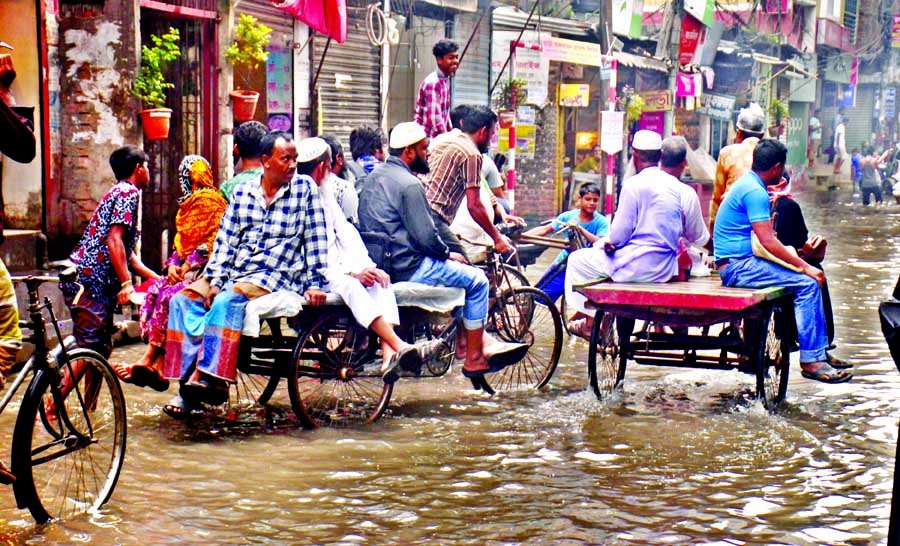
Sagar Biswas :
Heavy rain in the city on Tuesday created a hazardous condition for the residents while the situation worsened in different parts due to waterlogging. The city dwellers, especially the day labourers, suffered much as rain disrupted their normal pace of life.
Officials of Department of Meteorology said the rain is expected to continue for another couple of days but the monsoon in the state is likely to last till August end.
Several important city streets went under water in Old Dhaka, Farmgate, Mouchak, Malibagh, Shantinagar, Razarbagh, Rampura, Banasree, Bashundhara, greater Mirpur which resulted to nagging traffic congestions.
“For days and months we have been troubled by the construction of the flyover and now with the rains. The road inside our colony has always been bad but with the continuous showers, there is no road left. It is just the big potholes filled with water,” Rumana Islam, a bank official and resident of Malibagh area, said on Tuesday.
Apart from the office-goers, the students had to suffer a lot due to water loggings at a good number of points. Particularly, the situation turned worse in Rampura, Chowdhurypara and Mouchak where roads construction work under different development projects were underway.
In fact, most of the city roads are now in dilapidated condition. It is very hard to move on these roads in normal time. The situation turned into worse after heavy shower. But the two City Corporations, Dhaka North and South, failed to keep the roads intact. The potholes turn into ditches due to movement of heavy vehicles, such as truck and bus.
The traffic jam condition was severe that it took three to four hours for a bus to run between Savar to Farmgate. Supervisor of Welcome Paribahan Babul Mia said, “We started for Dhaka from Savar at 11 am. We reached at Farmgate at 2:45 pm. It is almost four hours.”
Supervisor of another paribahan which runs between Bangabandhu Avenue and Abdullahpur said that the vehicles were locked at several points including Banani, Mohakhali, Bijoy Sarani, Farmgate, Karwan Bazar and Shahbagh.
The situation was highly miserable in the low-lying areas where many houses and shops went under water. Several shops in the city’s Kazipara and Shwerapara were shut down as rain water entered there.
Chief Additional Engineer of DSCC Mohammad Asaduzzaman said, “Due to potholes, we’re facing waterlogging situation in some city streets. We’re trying to repair the potholes. The city corporation, however, will start full-fledged repairing work after the end of rainy season.”
Experts said the management of drainage system of Dhaka City is presently a challenge for the urban authorities because of rapid growth of population and unplanned development activities. Not only that, the waterlogging becomes a burden for the inhabitants of Dhaka and creating adverse social, physical, economic and environmental impacts.
The stagnant storm water leads to the creation of breeding sites for diseases vectors that becomes a hazard to health as well as being unsightly and foul smelling. Therefore, a close coordination among urban authorities and agencies and collaboration between public and private sectors is needed, the experts said.
It is learnt that, Dhaka has lost huge amounts of wetlands over time despite the enactment of the Water Body Conservation Act 2000. About 80 percent of Dhaka city is drained through these channels and the city is divided into 12 drainage zones based on the topography of the area, khal systems and surrounding rivers.
But the situation has changed now. The Dholai Khal, that once used to be an essential route for boats, has nearly vanished due to the government’s detrimental policies. Another one, the Segunbagicha Khal — starting from Shahbagh to Jirani Khal — is now mostly under illegal occupation. Besides, Begunbari Khal, Ibrahimpur Khal, Gopibagh Khal and many other canals have similarly come under encroachment.

